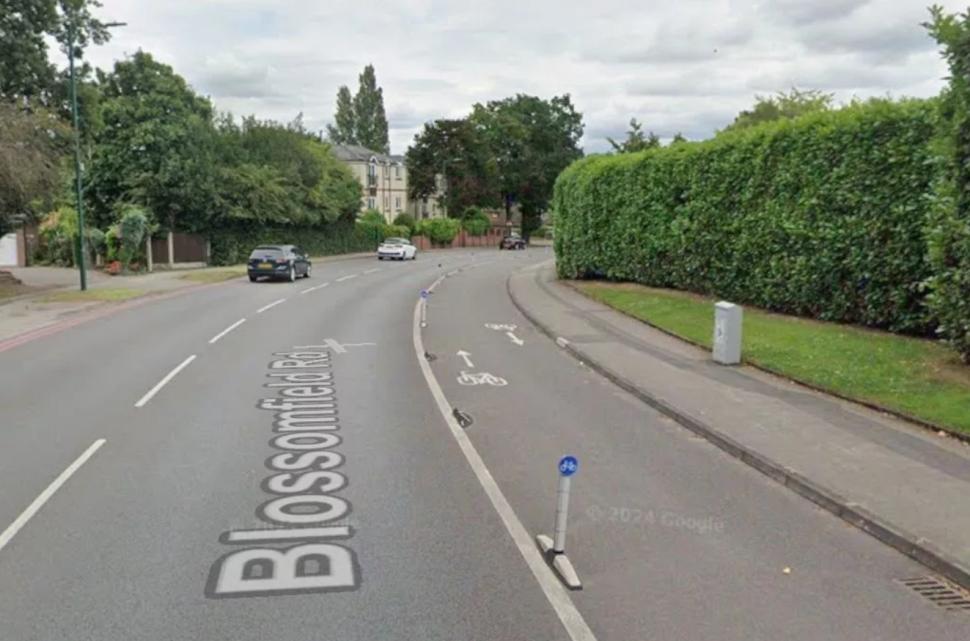Solihull Council has announced plans to upgrade its main segregated cycle lane into the town centre to prevent delivery drivers blocking it.
The two-way cycle lane on Blossomfield Road was constructed in 2022 and replaced a narrow painted lane. It is 1.2 miles long and extends past three secondary schools and a college. Council data has shown an increase of 41 per cent in cycling along the road since its installation.
Besides wands – narrow bollards – the cycle lane is also segregated through several short so-called ‘orca kerbs’ made of rubber that deter vehicles from crossing the lane.
However, the kerbs used in Solihull are sparsely placed out, enabling vehicles to cross over into the cycle lane without hitting the attached bollard. The cycle lane is also intersected by so-called ‘floating bus stops’ along the route.
> Pensioner left with broken wrist and black eye after tripping over cycle lane separator
At a recent council meeting, Reform UK Cllr Samantha Gethen said “The orcas and wands are a bit dangerous – we have had residents fall over the orcas.
 Blossomfield Road, Solihull (credit: Google Maps Street View)
Blossomfield Road, Solihull (credit: Google Maps Street View)
“Everyone I speak to says it looks unsightly so a kerb is the best option,” Gethen added, as reported by Birmingham Live’s Local Democracy Reporter.
Liberal Democrat councillor Kathryn Thomas added “I do know we haven’t won hearts and minds on this. A lot of it is the changes we have made to the bus stops – this strategy of now having buses stop in the road.”
But, defending the new infrastructure, Thomas added “people don’t understand even if they get rid of the cycle route you are still going to have the buses stopping in the road.
“It serves schools, the college – young people are more likely to cycle. If it saves the life of a child then it is worth it.”
At the meeting to discuss alternative arrangements, it was revealed that funding from central government and Transport for West Midlands – the region-wide public transport authority – would be available to replace the orcas with a permanent kerb fully segregating the cycle lane from the road traffic. The installation would cost £498,204 and would be installed by March 2027 pending resident consultation.
However, local residents reacted angrily on Facebook to the proposed investment, with more than 100 mostly negative commenters describing the decision as “a waste of taxpayer’s money” on a cycle lane they feel is rarely used.
“A 41% increase but what was the original number? 5 or even 10 maybe. Stats can be used whichever way they want. 100% of nothing is still nothing,” wrote Dee King.
“Wow in such difficult financial times surely nearly half a million pounds can be put to better use…” added Lucy Harris.
Solihull Cycling Club’s Racing Coordinator meanwhile chose to stir up the debate. “Scrap the cycle lane and make it 20mph with avg speed cameras 👍” David Fellows typed.
At the time of the lane’s initial installation the West Midlands’ then Cycling and Walking Commissioner, Adam Tranter, responded to criticism of the infrastructure by saying “In truth — experienced cyclists who are cycling faster speeds, are more confident or are riding in groups, may prefer to continue to use the road, which is their right and totally acceptable under the Highway Code.”
The council’s Conservative Cabinet member for Environment and Infrastructure, Cllr Ken Hawkins at the time defended the weaker infrastructure, saying it “ensured that [the road space] can be used flexibly in case of emergencies.”
However, in the council meeting on Monday, Hawkins said “With this funding we have never hidden from what we want – a proper segregated route with kerbing to give greater safety for active travel users.
Hawkins previously attracted attention in 2019 when he was invited to ride a cycle lane on the high street in nearby Shirley and discovered first-hand how poorly it had been signposted and maintained.

